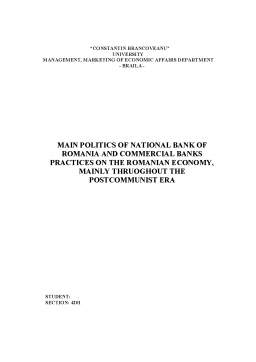Extras din proiect
On account of a few members of the Liberal party, all of them wealthy and pragmatic; with an western vision of the economic-financial future of Romania on April the seventeenth 1880 by parliamentary vote, was established the National Bank of Romania.
On the law project, there was taken as a model the Central Bank of Belgium principles, at the time, wich seemed to be a model to follow.
From the beginning of activities, year 1881 until the First World War,
the main objective followed by The National Bank of Romania was to
cater to the Romanian banking system wich was into incipient state, mainly through bonds.
In the time between the two world wars, the NBR increased more and more its activities, authorized the establishment for thousands of commercial banks surveyed financial-banking system activities, supported the national currency- LEU, wich at the time, was offset in gold, endorsed the establishment of the Romanian Stock Exchange.
Between the two world wars, from economic-financial development point of view, Romania succeded to come closer to the more developed western european countries, at that time.
After World War Two, under the soviet army occupation and a large collaborationism from the impoverished and free stated people, Romania became Republic of the People and the National Bank of Romania was nationalized, becoming Bank of the State. On the mean time, the whole banking system was nationalized were interrupted the links with western capitalist countries. In Romania under soviet influence became to be put on practice the economy and social organization from the Soviet Union.
From World War Two to 1990 the Bank of the State had absolute control on the financial flow and accumulated all of the banking operation. In ‘70s and ‘80s, for more than two decades, in the multilateral developed socialist society, in Romania existed yet, only 4 banks, like The Romanian Bank of Foreign Trade, The Bank of Agriculture and Food Industry, The Investment Bank and the House of Savings and Securities(CEC), all of them public companies, strictly controlled by the Bank of the State. The activity in this commercial banks was one of routine, predictable planned, without too much thrills. Only one of this ones, the House of Savings and Securities assumed the savings of the people, the offer of financial products being really low, rudimentary, the period of time to make a deposit was initially win for one year long, later for win six months, and the interest rate was symbolic, somewhere between( 0.5-3%) without much fluctuation.
The other commercial banks were working with public companies only, companies from industry, agriculture, only the Romanian Bank of Foreign Trade was involved in import-export financial activities. For the people, at the time, a so called crediting was possible only by the mean of the Reciprocal Aid Houses, organized on economic activity branches. The reform begins at the end of 1990, one year after the December 1989 revolution, being projected a banking system on two levels:
- on the first level, the Bank of State was been reorganized, being renamed the National Bank of Romania, and for commercial activities of the ex-Bank of the State till that moment, was been established the Romanian Commercial Bank(BCR).
- on the second level, by Government Decision, the former 3 public banks: the Romanian Bank of Foreign Trade, the Bank of Agriculture and Food Industry, the Investment Bank were transformed in commercial banks with public capital, diversifying its activities.
On the mean time from 1990 till 1992 were been established new private commercial banks, on the 31/1990 law basis, a special banking law wasn’t yet available. Only at the end of 1991, the law 33/1991 regulates the banking activities for commercial banks, and the law 34/1991 approves an status for the NBR, about two years after the December ’89 revolution. The declared objectives of the NBR were mostly: 1- the stability of the Romanian currency LEU and
2- the stability of the staple products and services.
Soon in ‘90s by speculating the legislative and authority emptiness, the corruption of the state administration and the lack of experience of the majority of people concerning the market economy, almost everything was possible for the unscrupulouses.
The passing from the socialist society with predictible and planified economy and banking to the western open market economy made evident soon after 1990s, the lack of strategy in the NBR management and in the Romanian banking system, mostly from 1990 to 2000, comparing with the west-european or American banking, towards we were heading for, in words but thanks to the competitive market economy, this countries were evolving continuously, after World War Two and they’re still advanced now.
Preview document
Conținut arhivă zip
- Main Politics of National Bank of Romania and Commercial Banks Practices on the Romanian Economy, Mainly Thruoghout The Postcommunist Era.doc







